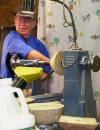|
That Was Then....
 One Sunday morning in 2000 I saw an ad in the local newspaper from
“Woodcraft”, advertising lessons in making wooden bowls using a lathe.
After 2 days and 7 hours of lessons ranging from sharpening various gouges
and scrapers and their use, I learned how to turn a bowl starting from
a log - in August of 2000, at the age of 62, I (and my frazzled instructor)
finished ‘my’ first bowl, a natural edge bowl from African Sumac. I was hooked!”
With my newly purchased $700 JET Lathe and a handful of gouges, scrapers,
a skew and a parting tool I became addicted to flying ribbons of wood and
I haven't looked back.
One Sunday morning in 2000 I saw an ad in the local newspaper from
“Woodcraft”, advertising lessons in making wooden bowls using a lathe.
After 2 days and 7 hours of lessons ranging from sharpening various gouges
and scrapers and their use, I learned how to turn a bowl starting from
a log - in August of 2000, at the age of 62, I (and my frazzled instructor)
finished ‘my’ first bowl, a natural edge bowl from African Sumac. I was hooked!”
With my newly purchased $700 JET Lathe and a handful of gouges, scrapers,
a skew and a parting tool I became addicted to flying ribbons of wood and
I haven't looked back.
This is Now...
After 56 years in the semiconductor
industry, Charlie is now retired, and turning to
his hearts content. “I now have a Vicmarc VL300 lathe,
which is much smarter than I am and probably 70 odd gouges, scrapers, parting tools (and that
one darned skew—somewhere), along with Eliminators, Center Saver Systems,
Mahoney’s magical tools, texturing tools, to name a few. All these tools have promised
to make me as fast as Mahoney and as precise as Drozda.“I think I need more
practice!--or maybe just one more new tool”?
than I am and probably 70 odd gouges, scrapers, parting tools (and that
one darned skew—somewhere), along with Eliminators, Center Saver Systems,
Mahoney’s magical tools, texturing tools, to name a few. All these tools have promised
to make me as fast as Mahoney and as precise as Drozda.“I think I need more
practice!--or maybe just one more new tool”?
Other than the two classes referenced above,
Charlie is self taught. He has attended two Desert Woodturning Roundup
Symposiums sponsored by the Arizona Wood Turners Association, where he could
observe the work of many of the leading woodturners in the world and see
the latest available tools demonstrated. He subscribes to “More Woodturning”
and “Woodturning Design” magazines that often contain helpful hints and
suggestions. He is a member of the American Association of Woodturners
and enjoys their publication “American Woodturner.”
My Kind of Bowls -- a love
of Stone Inlay...
"I love to use stone inlay whenever there seems
to be a place for it -- I seek out those one-of-a-kind "tortured" logs with
splits  and knots and wormholes and severe cracks, the more imperfections the better.
I will then highlight them with stone inlay or just leave as is in order
to expose the rugged beauty that once was hidden from view. For the
stone inlay I use a lot of Turquoise but also Azurite, Coral, Chysocolla,
Lapis, and Malachite."
and knots and wormholes and severe cracks, the more imperfections the better.
I will then highlight them with stone inlay or just leave as is in order
to expose the rugged beauty that once was hidden from view. For the
stone inlay I use a lot of Turquoise but also Azurite, Coral, Chysocolla,
Lapis, and Malachite."
Over the last few years most of my work has
been Natural Edge bowls. The Natural Edge bowls retain the outer
sapwood within the outer rim of the bowl in the exact contours of the original
log; I am often able to even retain the bark from the log. I still
turn the popular large 10-15 inch salad mixing bowls, never missing an opportunity
for stone inlay if an imperfection is exposed.
Nothing compares to the experience of taking
a piece of wood and watching a shape develop while revealing the secrets nature
has hidden in its grain. "I don't think of myself as an artist...perhaps
an intermediate level craftsman."
All of Charlie's bowls are one of a kind....
|
|